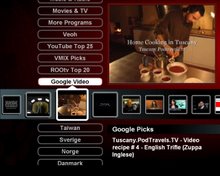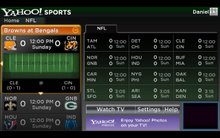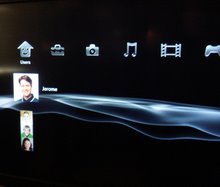Digital-Enthusiasts PC Users,
Last week there was a NY-Times article very critical of Digital-Home developments. I agreed with most of the comments. Many readers responded to the article, see http://www.nytimes.com/packages/html/technology/circuits.html
About 80% of responders shared the negative view of what has so far been offered to the consumer. Here is a good example:
"I concur with Steve Jobs: I run to my TV for escape. I carry a BlackBerry during the day and am not afraid to use it. I have a Bluetooth earpiece that I wear even in the office. I'm wireless autosyncing every 2 minutes. BUT when I get home at night, especially if the day was bad, I watch old cartoons, 'Three Stooges,' or 'Murder, She Wrote'-as far removed from my reality as I can find. You come anywhere near my TV with that Internet Ethernet cable, and I will shoot to kill."
The NYTimes author responds with “As for me, I say: agreed. Call me when it's all in one component with one remote and one cable to the TV.”
Active-TV technology has taken the critic above into consideration more than any other PC-industry approach. The objective is a single STB with the video-content delivered directly to the box. Thin-client technology is integrated into the box, resulting in a single IR remote. Active-TV technlogy does not turn a PC into a media-hub or media-server – keeps the PC out of the critical path – better supports notebook users.
I think the Steve Jobs’ Front Row UI for the TV is wonderfully better than the current Media Center 10-foot UI. Active-TV colaborators are working to build Media Applications (TV-web channels) which are not like PC web pages but are interesting, useful and attractive to the critic above. Too many of the existing MCE Spotlights look like web pages – and remind me and the critic above of looking at the PC monitor at work.
Media Applications must make the TV more interesting, more relaxing and more enjoyable, even for our critical reviewers. The kids can choose MTV-Overdrive. The comment: “far removed from my reality”, indicates an interest in long-tail-content. The Media Application is ideally suited to finding and enjoyably presenting long-tail-content – An example of this is the BBC iMP.
Active-TV technlogy continues to benefit from getting non PC industry colaborators helping determine the Media Applications which really resonate with a wide audience.
Navigate YouTube available at iTunes App Sore
An easy to use iPhone and iPod touch App that enables both new and advanced YouTube users to get the best from YouTube.
Browse video Standard Feeds, Categories, Channels and Playlists. Then organize new videos into your own favorites and playlists. Make playlists private or public. Subscribe to other user's playlists and video collections for future viewing. Subscribe to videos matching search-words.
Look at publicly viewable favorite videos, playlists and subscriptions based on your YouTube friends, family and contacts. Send and receive video links with YouTube contacts via YouTube video messages.
Search for new videos tagged for your language or geographical region, using local keyboard. Explore for new videos via easy switching of user ID to the owner of interesting videos - then explore their world.
All actions are kept in sync with PC, Mac or Apple-TV access to YouTube. Available at Apple App Store.
Browse video Standard Feeds, Categories, Channels and Playlists. Then organize new videos into your own favorites and playlists. Make playlists private or public. Subscribe to other user's playlists and video collections for future viewing. Subscribe to videos matching search-words.
Search for new videos tagged for your language or geographical region, using local keyboard. Explore for new videos via easy switching of user ID to the owner of interesting videos - then explore their world.
All actions are kept in sync with PC, Mac or Apple-TV access to YouTube. Available at Apple App Store.
active-TV technology for PC

Windows PC based home network
Friday, December 16, 2005
Tuesday, December 6, 2005
Apple Pod or Mac-Mini ?
Active-TV Ecosystem Developers
There are many rumors about an Apple platform announcement in January. Speculating about this platform is an interesting process, as it may give us insight applicable to our own Extended-Notebook strategy. In this email, I am calling it “the-new-box” from Apple.
Most reporters talk about a new living room Mac-mini. I think consumers understand Mac to be a PC brand with the OS-X operating system. This would indicate they expect a keyboard and mouse to be attached to this new Mac – so they can run all the Mac applications. If this is what the-new-box looks like, then it is not very new.
Since it is in the living room it has to support the 10’ Front Row UI. Including the usual 2’ UI means it is a hybrid Mac-PC, just like the current Modern Living iMac. This is not very interesting – just an Apple variant of the Microsoft Media Center idea.
No doubt Apple would also like to get the BOM (cost) for the-new-box down – making it more profitable. Lowering the cost of a Hybrid-PC has disadvantages; it makes the 10’ features more affordable, but it can undermine traditional 2’ platform business. If a hybrid Media Center like PC costs less than a PC, then why buy a PC – buy the hybrid and only use the 2’ operation.
Apple (and the user) only need the 10’ Front Row UI at the living room location. Dedicating the platform to 10’ operation has many benefits: it lowers the BOM; it reduces support and maintenance issues; it reduces processor requirements as well as heat and noise; it focuses the value-proposition to the end user; it prevents undermining other 2’-only platforms; it may simplify set-up and installation; it may appear to be more secure regarding content protection; finally and most importantly, it better enables support for Apple notebooks.
For these reason I think of the-new-box is not a Mac but a Pod. Currently, users think of Pods supporting dedicate photo and music access. The AirportExpress is a kind of Pod – it’s a peripheral to an iMac. The AirportExpress does not have a UI, but if the Front Row UI was added, then I think Apple would call it Pod-like rather than iMac-like.
Other things we can expect are a high-def video-out and the Front Row UI being controlled by Apple’s new 10’ remote – with the spinning pod-wheel. [The UI, including the remote, is part of the brand.] No doubt surround sound will complete the high-quality entertainment nature of the-new-box. Some say an iPod dock-connector will be built-in.
However, I don’t think the-new-box will be a DMA or Extender – these ideas have not met with market acceptance. Apple will likely build the-new-box support into some already understood appliance – the most likely being a broadcast-enabled STB. Maybe the STB will support analog Tivo-like recording – but the quality of this approach does not fit with high-def or Apple-quality expectations. They could solve this problem by building high-def ATSC TV support into the-new-box.
The-new-box CPU is from Intel. This limits the prospects for embedded CA (Conditional Access) appearing in the box. They could add CableCard to support cable TV access – but I guess not.
I am drawing a picture of the-new-box not being a second computer, but having more standalone capability than an Extender or DMA. As suggested, adding broadcast reception helps achieve this. The future direction for the high-end STB is to add IP-TV support – some form of IP-TV support seems certain for the-new-box. So, the-new-box is not a Mac, not a second computer, but likely a dedicated 10’ hybrid-STB with networking to an Apple iBook or iMac.
Since Front Row support requirements are less than Media Center applications, maybe Front Row can be supported by the-new-box acting alone. That is unlike the Extended-Notebook approach - Front Row would be available even if the supporting notebook was not turned on – hence not projecting the 10’ UI over the network. Unlike most PC suppliers, Apple can make money from the-new-box as well as the iBook.
To extend the standalone nature of the-new-box, Apple could build upon its iDisk Service. Allowing the-new-box to access all the users’ content and paid-to-view movies from the iDisk. A broadband connection is required to support IP-TV, why not also use it to generate a monthly fee from iDisk services – why buy a NAS when there is iDisk!. The approach makes the-new-box more standalone and may offer higher security for paid-to-view movies.
[iDisk is a service offered by Apple to all .Mac members so that they may store their digital photos, movies or personal files online. Currently, .Mac users get a total storage amount of 1GB for email and iDisk storage. iDisk appears as network drive mounted automatically. Mac OS-X allow users to use their iDisk when offline, and synchronize with it when they go online. ]
Content distribution via an IP-TV and iDisk approach would still have to give access to more than just Hollywood content. It would be much better to support long-tail content which is unique and not available by any other method.
Would the-new-box work with ViiV? I think to the extent that they are both based on UPnP, there would be some interoperability. This would also be true for a Windows XP Home PC which supports Windows Media Connect (WMC – also based on UPnP).
Since 2’ operation is not in the-new-box, there would have to be networking to an iBook (or iMac). Activities which are 2’, such as photo editing, library management, content creation or reformatting, would remain 2’ and not be directly supported in the dedicated 10’-only new-box. With home networking, content and anything else, could be freely moved between the-new-box, an iBook and iDisk.
This is all speculation. I hope the debate is useful even if the predictions are all wrong. Comments corrections and feedback welcome.
There are many rumors about an Apple platform announcement in January. Speculating about this platform is an interesting process, as it may give us insight applicable to our own Extended-Notebook strategy. In this email, I am calling it “the-new-box” from Apple.
Most reporters talk about a new living room Mac-mini. I think consumers understand Mac to be a PC brand with the OS-X operating system. This would indicate they expect a keyboard and mouse to be attached to this new Mac – so they can run all the Mac applications. If this is what the-new-box looks like, then it is not very new.
Since it is in the living room it has to support the 10’ Front Row UI. Including the usual 2’ UI means it is a hybrid Mac-PC, just like the current Modern Living iMac. This is not very interesting – just an Apple variant of the Microsoft Media Center idea.
No doubt Apple would also like to get the BOM (cost) for the-new-box down – making it more profitable. Lowering the cost of a Hybrid-PC has disadvantages; it makes the 10’ features more affordable, but it can undermine traditional 2’ platform business. If a hybrid Media Center like PC costs less than a PC, then why buy a PC – buy the hybrid and only use the 2’ operation.
Apple (and the user) only need the 10’ Front Row UI at the living room location. Dedicating the platform to 10’ operation has many benefits: it lowers the BOM; it reduces support and maintenance issues; it reduces processor requirements as well as heat and noise; it focuses the value-proposition to the end user; it prevents undermining other 2’-only platforms; it may simplify set-up and installation; it may appear to be more secure regarding content protection; finally and most importantly, it better enables support for Apple notebooks.
For these reason I think of the-new-box is not a Mac but a Pod. Currently, users think of Pods supporting dedicate photo and music access. The AirportExpress is a kind of Pod – it’s a peripheral to an iMac. The AirportExpress does not have a UI, but if the Front Row UI was added, then I think Apple would call it Pod-like rather than iMac-like.
Other things we can expect are a high-def video-out and the Front Row UI being controlled by Apple’s new 10’ remote – with the spinning pod-wheel. [The UI, including the remote, is part of the brand.] No doubt surround sound will complete the high-quality entertainment nature of the-new-box. Some say an iPod dock-connector will be built-in.
However, I don’t think the-new-box will be a DMA or Extender – these ideas have not met with market acceptance. Apple will likely build the-new-box support into some already understood appliance – the most likely being a broadcast-enabled STB. Maybe the STB will support analog Tivo-like recording – but the quality of this approach does not fit with high-def or Apple-quality expectations. They could solve this problem by building high-def ATSC TV support into the-new-box.
The-new-box CPU is from Intel. This limits the prospects for embedded CA (Conditional Access) appearing in the box. They could add CableCard to support cable TV access – but I guess not.
I am drawing a picture of the-new-box not being a second computer, but having more standalone capability than an Extender or DMA. As suggested, adding broadcast reception helps achieve this. The future direction for the high-end STB is to add IP-TV support – some form of IP-TV support seems certain for the-new-box. So, the-new-box is not a Mac, not a second computer, but likely a dedicated 10’ hybrid-STB with networking to an Apple iBook or iMac.
Since Front Row support requirements are less than Media Center applications, maybe Front Row can be supported by the-new-box acting alone. That is unlike the Extended-Notebook approach - Front Row would be available even if the supporting notebook was not turned on – hence not projecting the 10’ UI over the network. Unlike most PC suppliers, Apple can make money from the-new-box as well as the iBook.
To extend the standalone nature of the-new-box, Apple could build upon its iDisk Service. Allowing the-new-box to access all the users’ content and paid-to-view movies from the iDisk. A broadband connection is required to support IP-TV, why not also use it to generate a monthly fee from iDisk services – why buy a NAS when there is iDisk!. The approach makes the-new-box more standalone and may offer higher security for paid-to-view movies.
[iDisk is a service offered by Apple to all .Mac members so that they may store their digital photos, movies or personal files online. Currently, .Mac users get a total storage amount of 1GB for email and iDisk storage. iDisk appears as network drive mounted automatically. Mac OS-X allow users to use their iDisk when offline, and synchronize with it when they go online. ]
Content distribution via an IP-TV and iDisk approach would still have to give access to more than just Hollywood content. It would be much better to support long-tail content which is unique and not available by any other method.
Would the-new-box work with ViiV? I think to the extent that they are both based on UPnP, there would be some interoperability. This would also be true for a Windows XP Home PC which supports Windows Media Connect (WMC – also based on UPnP).
Since 2’ operation is not in the-new-box, there would have to be networking to an iBook (or iMac). Activities which are 2’, such as photo editing, library management, content creation or reformatting, would remain 2’ and not be directly supported in the dedicated 10’-only new-box. With home networking, content and anything else, could be freely moved between the-new-box, an iBook and iDisk.
This is all speculation. I hope the debate is useful even if the predictions are all wrong. Comments corrections and feedback welcome.
Friday, December 2, 2005
Extended-PC and other terminology
Active-TV ecosystem developers,
There seems to be confusion over terminology relating to digital convergence. I offer my explanation of terminology below.
Extended-PC – A PC which ‘extends’ its value by networking to other non-PC clients around the house. The clients support entertainment consumption. The PC runs Windows XP or better. The Extended-PC can also network with other PCs.
Extended-Notebook – A Notebook which ‘extends’ its value by networking to other non-PC clients around the house. The Notebook runs Windows XP or better.
Extender – an entertainment client connected to an Extended-PC. In this case, the client uses Microsoft Extender middleware and the PC uses the Media Center Edition (MCE) OS.
PC Media Server – A PC placed at a 10-foot location such as a living room. It is controlled by an IR remote and has no keyboard or mouse.
X86 STB or x86 Media Server – This is the same hardware as the PC STB or PC Media Server, but the operating system is likely Lynx. Because the Windows OS is not used, consumers do not consider this to be a PC or have 2’ value.
Media Center PC – Microsoft do not try and sell the MCE without promoting its 2’ value – it’s a not a dedicated 10’ appliance. So the Media Center PC is a Hybrid-PC if it directly supports a 10’ UI, or an Extended-PC if it projects the 10’ UI to an Extender.
10-foot box – a box in the living room connected to a TV controlled by IR remote.
2-foot experience – using a keyboard, mouse and PC monitor
Middleware – connects Extended-PC with entertainment client
H264 - emerging high-def video codec, which may replace MPEG2
High def TV - TV signal supporting 720p or 1080i TV picture
ATSC - Broadcast standard used for high def terrestrial TV in USA
DVB-t - Digital Broadcast TV in Europe using terrestrial signaling (antenna)
Comments, corrections and feedback appreciated.
There seems to be confusion over terminology relating to digital convergence. I offer my explanation of terminology below.
Extended-PC – A PC which ‘extends’ its value by networking to other non-PC clients around the house. The clients support entertainment consumption. The PC runs Windows XP or better. The Extended-PC can also network with other PCs.
Extended-Notebook – A Notebook which ‘extends’ its value by networking to other non-PC clients around the house. The Notebook runs Windows XP or better.
Extender – an entertainment client connected to an Extended-PC. In this case, the client uses Microsoft Extender middleware and the PC uses the Media Center Edition (MCE) OS.
- The UI of the Extender is identical to the 10’ UI of the MCE PC.
- A DMA, like an Extender, has only 10’ value – there is no keyboard or 2’ UI support.
- It primary function is to support the consumption of entertainment content
- As explained below (hybrid-Notebook), this is the ideal entertainment client for combining with a notebook.
PC Media Server – A PC placed at a 10-foot location such as a living room. It is controlled by an IR remote and has no keyboard or mouse.
- Lack of a keyboard means this PC has no 2-foot value - Consumers do not believe they are buying a PC.
- Use of the Windows Operating System (or MCE) means this platform has much of the maintenance requirements of a PC.
- This platform has the BOM (cost) of a PC but must compete with BOM of alternative 10’-only appliances or Extender.
- This platform is considerably more powerful and flexible than a traditional 10’-only appliance.
- Microsoft moved away from this idea when they dropped the 2-foot thin client (Mira) which was intended to be a companion to the PC Media Server.
- Clearly its 2-foot role requires it to have a keyboard.
- In support of its 10-foot role, its 10’ UI is controlled by an IR remote.
- The Hybrid-PC can be located in a living room and connected to a TV.
- If the TV is High-Def then the 2’ monitor is not needed to maintain the PC operation. (maintenance is a 2’ operation)
- Alternatively, the TV is not needed if the TV programs are presented on the 2’ monitor – student dorm-room style. (This hybrid form was the first way used to show-off the MCE. Microsoft can now use the Extender and Xbox360 to show the Extended-PC approach)
- A Hybrid-PC can also be an Extended-PC if it supports a 2nd 10’ UI via a networked Extender.
- Consumers believe they are buying a PC and are willing to pay for 2-foot value with the additional benefit of 10’ UI support.
- Notebooks are better suited to Extended-Notebook operation. Were the 10’ UI is projected to an Extender or other entertainment thin-client.
- A TV tuner can be added to a notebook, but it is difficult to deal with cable or satellite TV by this route.
- Like other hybrid offerings, there are a diminished number of users who want 10’ features built into a platform primarily purchased for its 2’ value.
- Currently, consumers find it easier to think of the 10’UI as extra TV channels.
X86 STB or x86 Media Server – This is the same hardware as the PC STB or PC Media Server, but the operating system is likely Lynx. Because the Windows OS is not used, consumers do not consider this to be a PC or have 2’ value.
- Without the Windows OS, this high-end STB is attractive to many users who don’t want the maintenance of a PC.
- What is left-out of a 10’ box is as important as what is ‘in’. Leaving Windows ‘out’ focuses the box on its 10’ usage. Similar thinking can be seen in Apple’s Front Row, were they left many 2’-like things out which appear in the MCE 10’ UI.
- It is also likely easier to convince the security minded, that an box not running Windows or supporting a 2-foot UI, limits illegal access to protected video content.
Media Center PC – Microsoft do not try and sell the MCE without promoting its 2’ value – it’s a not a dedicated 10’ appliance. So the Media Center PC is a Hybrid-PC if it directly supports a 10’ UI, or an Extended-PC if it projects the 10’ UI to an Extender.
10-foot box – a box in the living room connected to a TV controlled by IR remote.
2-foot experience – using a keyboard, mouse and PC monitor
Middleware – connects Extended-PC with entertainment client
H264 - emerging high-def video codec, which may replace MPEG2
High def TV - TV signal supporting 720p or 1080i TV picture
ATSC - Broadcast standard used for high def terrestrial TV in USA
DVB-t - Digital Broadcast TV in Europe using terrestrial signaling (antenna)
Comments, corrections and feedback appreciated.
Labels:
DMA,
Extended-PC,
Extender,
Front Row,
HT-PC,
MCE,
media server,
xbox
Subscribe to:
Posts (Atom)









